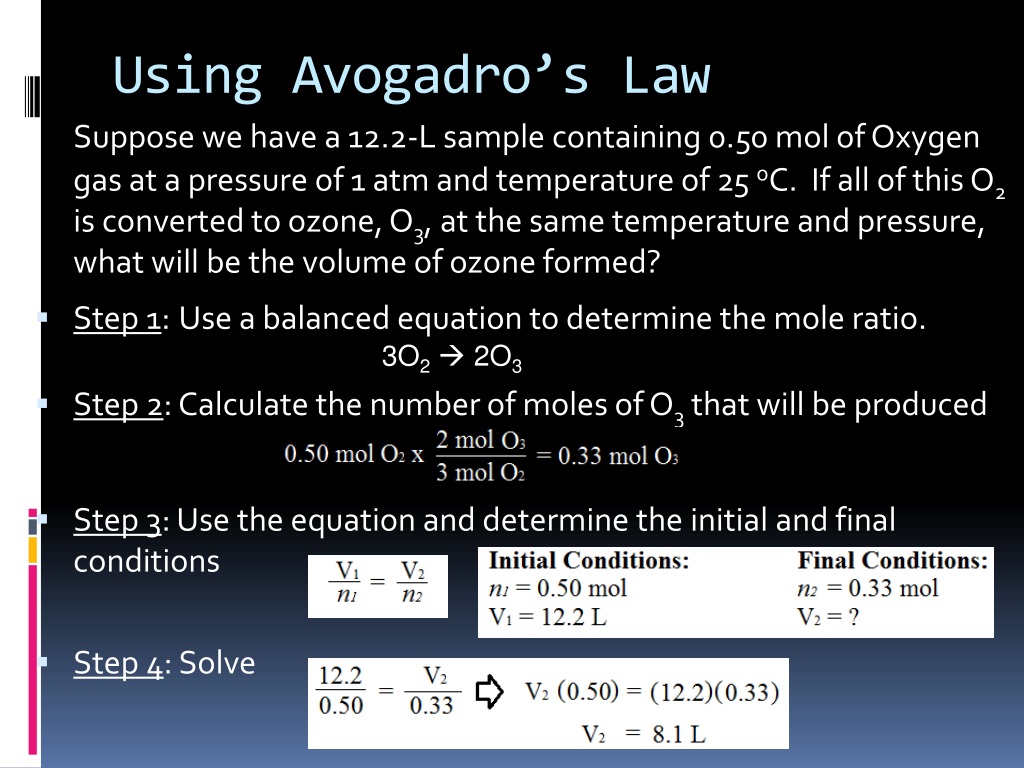Avogadro's law only approximates What the behavior of real gases. Avogadro's Law is in evidence whenever you blow up a balloon. The volume of the balloon increases as you add moles of gas to the balloon by blowing it up. If the container holding the gas is rigid rather than flexible, pressure can be substituted for volume in Avogadro's Law. Avogadro’s Law allows us to write a gas law that is valid not only for any P, V, or T but also for any mass of any gas! Avogadro’s law states that equal volumes of gases contain the same number of particles if they are at the same temperature and pressure. This holds true for all gases. Gases are often compared at a standard temperature and pressure of 1 atm and 273 K. This is also referred to as STP.
A flat tire is not very useful. It does not cushion the rim of the wheel and creates a very uncomfortable ride. When air is added to the tire, the pressure increases as more molecules of gas are forced into the rigid tire. How much air should be put into a tire depends on the pressure rating for that tire. Too little pressure and the tire will not hold its shape. Too much pressure and the tire could burst.
Avogadro's Law
You have learned about Avogadro's hypothesis: equal volumes of any gas at the same temperature and pressure contain the same number of molecules. It follows that the volume of a gas is directly proportional to the number of moles of gas present in the sample. Avogadro's Law states that the volume of a gas is directly proportional to the number of moles (or number of particles) of gas when the temperature and pressure are held constant. The mathematical expression of Avogadro's Law is:
[V = k times n]
or
[dfrac{V_1}{n_1} = dfrac{V_2}{n_2}]

where (n) is the number of moles of gas and (k) is a constant. Avogadro's Law is in evidence whenever you blow up a balloon. The volume of the balloon increases as you add moles of gas to the balloon by blowing it up.
If the container holding the gas is rigid rather than flexible, pressure can be substituted for volume in Avogadro's Law. Adding gas to a rigid container makes the pressure increase.
Example (PageIndex{1})
Vermintide 2 steam chart. A balloon has been filled to a volume of (1.90 : text{L}) with (0.0920 : text{mol}) of helium gas. If (0.0210 : text{mol}) of additional helium is added to the balloon while the temperature and pressure are held constant, what is the new volume of the balloon?
Solution
Steps for Problem Solving | |
|---|---|
| Identify the 'given' information and what the problem is asking you to 'find.' | Given: (V_1 = 1.90 : text{L}) (n_1 = 0.0920 : text{mol}) Find: (V_2 = ? : text{L}) |
| List other known quantities. | Note that the final number of moles has to be calculated by adding the original number of moles to the moles of added helium. (n_2 = 0.0920 + 0.0210 = 0.1130 : text{mol}) |
Plan the problem. | First, rearrange the equation algebraically to solve for (V_2). [V_2 = frac{V_1 times n_2}{n_1}] |
Calculate. | Now substitute the known quantities into the equation and solve. [V_2 = frac{1.90 : text{L} times 0.1130 : cancel{text{mol}}}{0.0920 : cancel{text{mol}}} = 2.33 : text{L}] |
| Think about your result. | Since a relatively small amount of additional helium was added to the balloon, its volume increases slightly. |
Exercise (PageIndex{1})
A 12.8 L volume of gas contains .000498 moles of oxygen gas. At constant temperature and pressure, what volume does .0000136 moles of the gas fill?
0.350 L
Summary

- Calculations for relationships between volume and number of moles of a gas can be performed using Avogadro's Law.
Avogadro's Gas Law Ppt
Contributions & Attributions
This page was constructed from content via the following contributor(s) and edited (topically or extensively) by the LibreTexts development team to meet platform style, presentation, and quality:
Avogadros Law Definition

Avogadro's Law Calculator
CK-12 Foundation by Sharon Bewick, Richard Parsons, Therese Forsythe, Shonna Robinson, and Jean Dupon.
Marisa Alviar-Agnew (Sacramento City College)
Henry Agnew (UC Davis)
